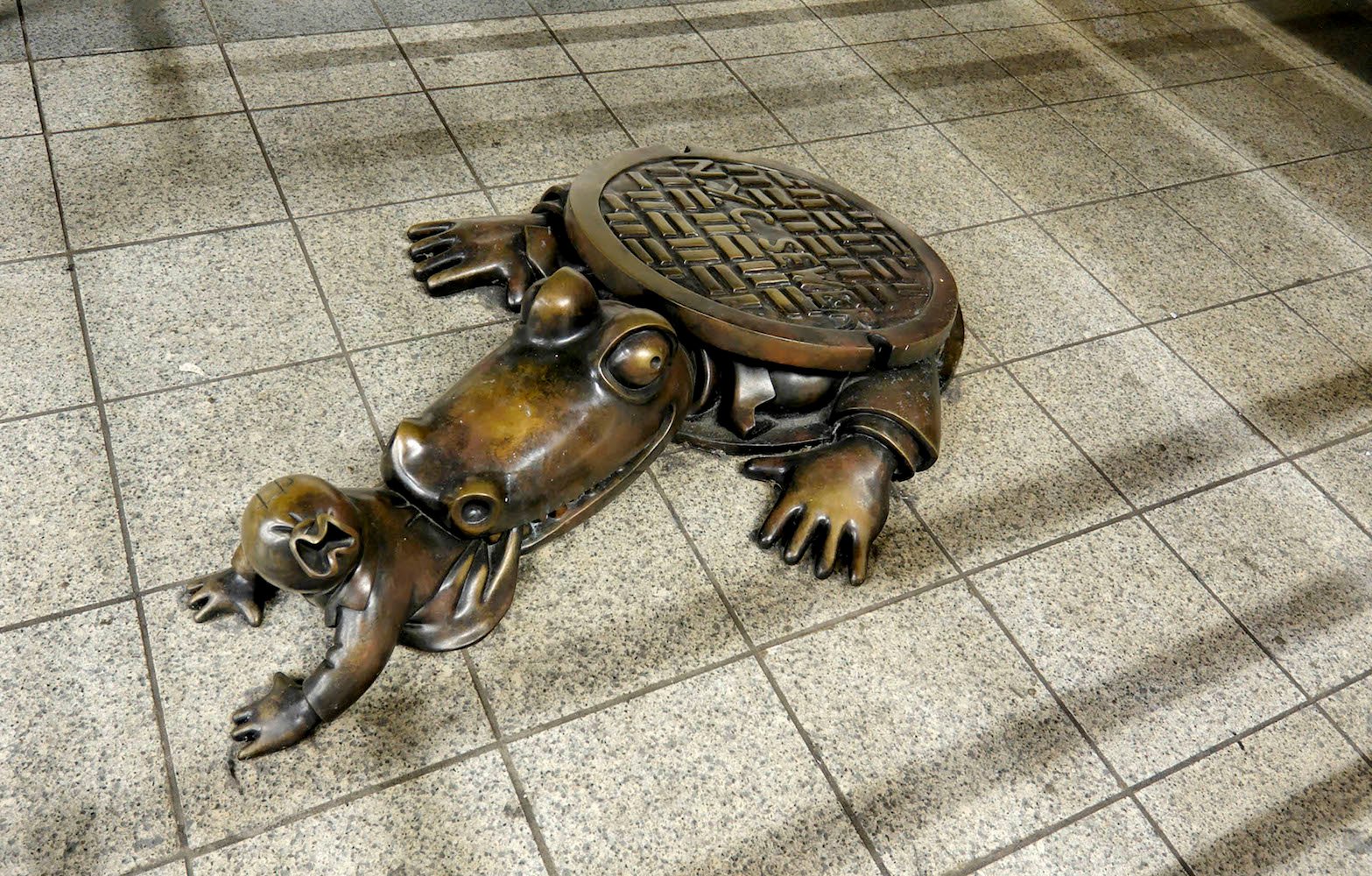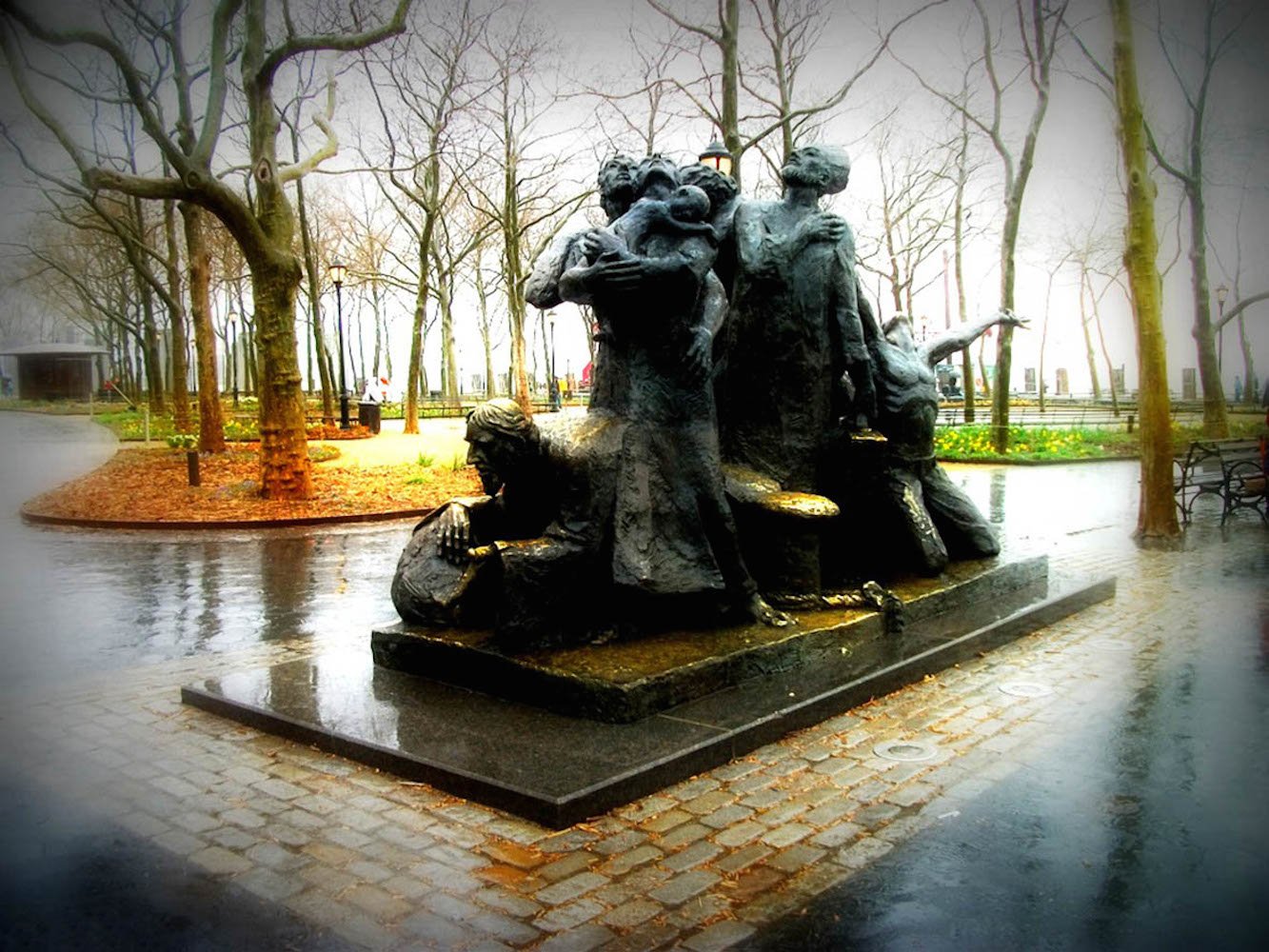Manhattan mystery: The playful works of Tom Otterness provide plenty of amusement for visitors to New York
The Big Apple might still be on most people’s bucket list, but those people could still be referencing a romantic view of the city in a bygone era.
Intoxicated by the flashy façade, they might have missed that what’s left of Little Italy, for instance – a once essential aspect of the city’s multicultural make-up and stronghold of legendary Mafiosi such as Ignazio “The Wolf” Lupo and Gambino crime boss John Gotti – is the dreary commercialised drag of Mulberry Street.
Or that everything that once afforded a hip barrio like Times Square its big-city street cred (the Mickey Rourke lookalikes emerging from the boxing gyms, the pencil-moustached hustlers under low-burning street lights …) was lost in the oversanitised wake of the Giuliani purge.
Hell, you now draw stares usually reserved for potential terrorists when you light up a cigarette in Central Park. What remains is nothing more than a cascade of cops poised to pounce on jaywalking tourists. And a mere whiff of its once thriving creative spirit – the residues of which I thankfully encountered late one afternoon while waiting for the Staten Island ferry.
Ambling through Battery Park (so named for the erstwhile military batteries overlooking the Hudson), I was forced to an abrupt halt before Clinton Castle – the former processing facility for newly arrived immigrants from 1855 to 1890 before it was moved to nearby Ellis Island.
What stopped me in my tracks was a work of art – or rather one of the most arresting attempts at it I had ever come across. In a clumsy lunge to capture the spirit of diversity injected by the wave of new arrivals to New York (more than seven million during the latter half of the 19th century), sculptor Luis Sanguino constructed a larger-than-life bronze on red Minnesota granite depicting freshly arrived immigrants to the United States – and in a spurt of astounding creativity, decided to call it The Immigrants.
The figure at the front, sinking down on to his knees in his new homeland, seems to be worshipping the very ground he finds himself on. Behind him a man and his wife cradling their newborn cast their gazes melodramatically heavenward in a state of unbridled enthrallment.
Behind them, two others, also with heads tilted skyward: one with a suitcase in one hand and the other clamped over his heart like a bumbling off-Broadway thespian, and the other, also on his knees with arms spread wide in heartfelt thanksgiving. Next to them, one man’s head drops into his hand in disbelief at his turn of luck, while an adjacent kneeling figure clasps his palms together in a sobbing prayer to whatever force transported him to this hallowed ground.
There they huddled in an orgy of oozing sentimentality – a grotesque monument to the conspicuous affectedness, the histrionic public outpouring that has become the hallmark of the American public persona. Could the creator of this sanctimonious, chest-thumping effigy have found his inspiration in the post-war US sitcom and TV drama, I wondered as I slunk away northwards along the river in a state of vicarious embarrassment.
Until, after some minutes and about a block west of Stuyvesant High, I was stopped in my stride once more. This time I was startled by a bulldog chained to one of the park’s water fountains, his leash straining in an attempt to reach a cat skulking across the top of a nearby wall, while the cat in turn had its eye on an unsuspecting bird.
It was not real, of course. I would later come to realise that both predator and prey’s smooth bronze finish, with the interplay between hunter and hunted, are common themes in the work of Tom Otterness.

But shrugging it off at that moment as playful play park pranking by some child-friendly citizen with an artistic bent, I moved on – blissfully unaware that I was walking into a wide new world that, in reality, spanned perhaps half the breadth of a football field.
My next awareness was of adjoining chess and checkerboard facilities fixed on to a stone tablet. Regular accessories to any public park worth its salt, yes, except this one had tiny, seemingly faceless figurines engaging with the regular medieval props. One was carting off the bishop, another sat defiantly on top of some checkerboard tokens …
There was more evidence of these apparently featureless creatures interacting with larger sculptures as I ventured deeper into the Otterness realm: riding on the back of a dodo, grappling to lift the earpiece off a larger-than-life phone, or emerging, along with a series of raised bronze footprints, from the severed neck of a huge human head. I felt compelled to follow the footsteps.
The multitude of figures increased as I was sucked further into the fray: perched precariously on top of a Victorian lamp with hood and scythe as some sort of Grim Reaper, conversing with a tortoise in a top hat, burdened by a back-bending platform supporting a large cat held captive by cords around its feet and head. Somewhere another bent character laboured to cart a wheelbarrow filled with one-penny coins.
In fact, coins were everywhere: embedded in the walkways betwixt the path-finding feet and sticking out of inconspicuous nooks and crevices. All over this show, the tiny figures could be seen hauling money or rolling coins along to a central point, where a moat overflowing with the cash surrounded a toppling three-story structure.
Too literal perhaps? A little too Lewis Carroll meets Dr Seuss? Although Otterness obviously intended everyone, children included, to appreciate his work, a sombre, cynical tone evident on closer inspection elevates it way beyond child’s play. A serpentlike creature straddles the wobbly centrepiece. Its head, shaped to resemble an Electrolux vacuum cleaner, is buried in the task of sucking up change from the thick heap of coins upon which the flimsy structure rests.
 Tear-jerker: Luis Sanguino’s The Immigrants, a ‘sanctimonious, chest-thumping effigy’. (Griffin Boyce)
Tear-jerker: Luis Sanguino’s The Immigrants, a ‘sanctimonious, chest-thumping effigy’. (Griffin Boyce)
Perched on the crest of the collapsing building’s roof is a fiddling Nero-like version of Humpty Dumpty straining to strike a final chord before the entire house of cards sinks into the quagmire of fiscal filth. Its partner, already unseated, lies on the ground cracked in half with coins spilling from his bloated stomach – a sick yolk, so to speak, of his former self.
Inside the crumbling house, scenes of torture and mayhem become apparent and the general playfulness abates, replaced by an ominous sense of despair as everyone is engulfed by the weight of the wealth – drowning in their own sea of gluttony and greed.
Commissioned in 1986 and installed at Battery Park in 1992, it could comfortably be seen as a poignant early portent of the Wall Street meltdown – a counter to the overbearing Rambo-like posturing of Arturo Di Modica’s famous snorting bull just up the road at Bowling Green meant to embody financial robustness.
The overall message in the Otterness pieces might be as crude at that of The Immigrants, except Otterness is, thankfully, not taking himself so seriously. If the broad canvas of the city was Good Morning Vietnam, Otterness would be Robin Williams and Sanguino – in a sad parody of his name – Lieutenant Hauk.
“It’s a simple language; it’s a cartoon language; it’s smiley, button faces,” Otterness explained in a 2006 interview with the New York Times. “People aren’t thrown off by a language they don’t understand. It’s not a visual language you need a bachelor’s degree in fine arts to get.”
But despite his nonchalance, Otterness, as one critic commented:
“… sums up the best of old New York: industrious and diverse, free-spirited and playful – but with a brooding undertone …”
And if that undertone constitutes a reality check, then at least a part of Otterness must have had that in mind when he titled the collective piece The Real World, and it stands testimony to a city and its people who famously refused to partake in it. It’s not the only wisdom the Kansas-born iconoclast offered his adopted home town.
His unique signature creeps from crannies all across Manhattan. The lovable but rambunctious figures carrying such messages have clambered around the huge clocks at the entrance to the famous Hilton Times Square, for instance.
And down in the Fourteenth Street to Eighth Avenue subway station, a permanent sculptural group installation of more than a hundred cast bronze pieces, collectively entitled Life Underground, adorn the platform and stairways of the A, C, E and L lines.
Meticulously executed (it took 10 years to complete) and sensitive to its environment, it showcases the artist’s customary deft mix of mirth and moroseness. Here too, the little humanoids project familiar themes such as the class clash between white- and blue-collar citizens, lust for power, greed, corruption and oppression as they play out in everyday reality in that particular setting.
There’s a woman struggling with a huge subway token under her arm, a well-dressed fare-jumper crawling under a gate, a cop harassing a homeless woman. Two characters wielding a cross-cut saw stand poised to cut a beam holding up the stairway while a smartly attired sewer alligator gobbles up a passer-by. (The moneybag heads on some were borrowed from popular political cartoonist Thomas Nast).
His largest contribution must be Tom Otterness on Broadway, installed in 2005, which stretched all the way from Columbus Circle to One Hundred and Sixty Eighth Street Rockefeller Park and similarly depicted diverse cultural and social aspects of life on the island with an exuberant sense of subversiveness and irony.
Some, like the arts critic Olympia Lambert, might find his new urban mythology too trite and its messengers a trifle too cute (they undercut the work’s “more critical edge”, she claims), but the sheer impishness of his creations and the undercurrent of social anarchy are invogarating in a city that, many protest, has been direly lacking in real grit.
Someone has to put a bit of bite back into the Big Apple.